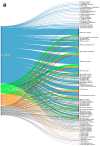Virological Passive Surveillance of Avian Influenza and Arboviruses in Wild Birds: A Two-Year Study (2023-2024) in Lombardy, Italy
- PMID: 40431131
- PMCID: PMC12114497
- DOI: 10.3390/microorganisms13050958
Virological Passive Surveillance of Avian Influenza and Arboviruses in Wild Birds: A Two-Year Study (2023-2024) in Lombardy, Italy
Abstract
Avian influenza (AI), caused by Alphainfluenzavirus (family Orthomyxoviridae), poses significant threats to poultry, biodiversity, and public health. AI outbreaks in poultry lead to severe economic losses, while highly pathogenic strains (HPAIVs) severely impact wild bird populations, with implications for biodiversity and potential zoonotic risks. Similarly, arboviruses such as West Nile virus (WNV) and Usutu virus (USUV) are emerging zoonoses. WNV can cause severe neurological diseases in birds, humans, and other animals, while USUV significantly affects blackbird populations and has zoonotic potential, though human cases remain rare. This study investigated avian viruses in 1654 wild birds from 75 species that died at the Wildlife Rescue Center in Vanzago, Lombardy, during 2023-2024. Necropsies were conducted, and virological analyses were performed to detect avian influenza viruses, WNV, and USUV. Among the tested birds, 15 were positive for H5N1 HPAIV clade 2.3.4.4b, all in 2023, including 13 Chroicocephalus ridibundus, one Coturnix coturnix, and one Columba palumbus. Additionally, 16 tested positive for WNV (15 for lineage 2 and one for lineage 1), one for USUV, and 11 co-infections WNV/USUV were recorded in 2023-2024. These findings underscore the importance of avian viral passive surveillance in identifying epidemiological trends and preventing transmission to other species, including mammals and humans.
Keywords: H5N1; HPAIV clade 2.3.4.4b; Usutu virus; West Nile virus; avian influenza; passive surveillance; wild birds.
Conflict of interest statement
The authors declare no conflicts of interest.
Figures





Similar articles
-
Continuous surveillance of potentially zoonotic avian pathogens detects contemporaneous occurrence of highly pathogenic avian influenza viruses (HPAIV H5) and flaviviruses (USUV, WNV) in several wild and captive birds.Emerg Microbes Infect. 2023 Dec;12(2):2231561. doi: 10.1080/22221751.2023.2231561. Emerg Microbes Infect. 2023. PMID: 37381816 Free PMC article.
-
Detection of West Nile and Usutu Virus RNA in Autumn Season in Wild Avian Hosts in Northern Italy.Viruses. 2023 Aug 20;15(8):1771. doi: 10.3390/v15081771. Viruses. 2023. PMID: 37632113 Free PMC article.
-
West Nile Virus and Usutu Virus: A Post-Mortem Monitoring Study in Wild Birds from Rescue Centers, Central Italy.Viruses. 2022 Sep 9;14(9):1994. doi: 10.3390/v14091994. Viruses. 2022. PMID: 36146800 Free PMC article.
-
The genetics of highly pathogenic avian influenza viruses of subtype H5 in Germany, 2006-2020.Transbound Emerg Dis. 2021 May;68(3):1136-1150. doi: 10.1111/tbed.13843. Epub 2020 Sep 29. Transbound Emerg Dis. 2021. PMID: 32964686 Review.
-
Emerging Trends in the Epidemiology of West Nile and Usutu Virus Infections in Southern Europe.Front Vet Sci. 2019 Dec 6;6:437. doi: 10.3389/fvets.2019.00437. eCollection 2019. Front Vet Sci. 2019. PMID: 31867347 Free PMC article. Review.
References
-
- Vogt N.A. Wild birds and zoonotic pathogens. In: Sing A., editor. Zoonoses: Infections Affecting Humans and Animals. Springer International Publishing; Cham, Switzerland: 2022. pp. 1–31.
-
- Blagodatski A., Trutneva K., Glazova O., Mityaeva O., Shevkova L., Kegeles E., Onyanov N., Fede K., Maznina A., Khavina E., et al. Avian influenza in wild birds and poultry: Dissemination pathways, monitoring methods, and virus ecology. Pathogens. 2021;10:630. doi: 10.3390/pathogens10050630. - DOI - PMC - PubMed
-
- ENETWILD Consortium. Flavia O., Sascha K., Carola S.-L., Christoph S., Valerie A., Alina A., Sophia B., Hannes B., Caroline B., et al. The role of mammals in Avian Influenza: A review. EFSA Support. Publ. 2024;21:8692E. doi: 10.2903/sp.efsa.2024.EN-8692. - DOI
LinkOut - more resources
Full Text Sources

